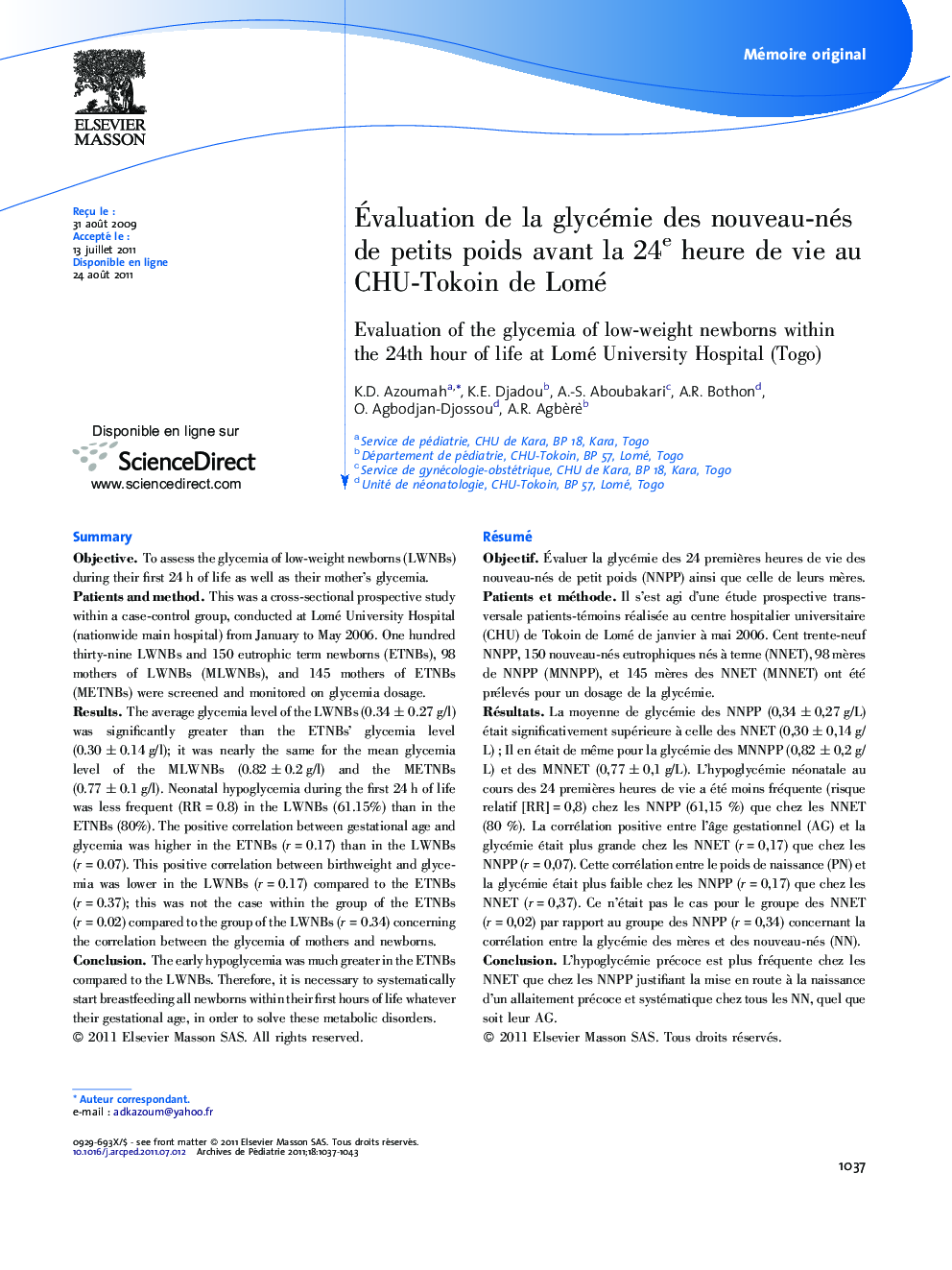| Article ID | Journal | Published Year | Pages | File Type |
|---|---|---|---|---|
| 4147813 | Archives de Pédiatrie | 2011 | 7 Pages |
RésuméObjectifÉvaluer la glycémie des 24 premières heures de vie des nouveau-nés de petit poids (NNPP) ainsi que celle de leurs mères.Patients et méthodeIl s’est agi d’une étude prospective transversale patients-témoins réalisée au centre hospitalier universitaire (CHU) de Tokoin de Lomé de janvier à mai 2006. Cent trente-neuf NNPP, 150 nouveau-nés eutrophiques nés à terme (NNET), 98 mères de NNPP (MNNPP), et 145 mères des NNET (MNNET) ont été prélevés pour un dosage de la glycémie.RésultatsLa moyenne de glycémie des NNPP (0,34 ± 0,27 g/L) était significativement supérieure à celle des NNET (0,30 ± 0,14 g/L) ; Il en était de même pour la glycémie des MNNPP (0,82 ± 0,2 g/L) et des MNNET (0,77 ± 0,1 g/L). L’hypoglycémie néonatale au cours des 24 premières heures de vie a été moins fréquente (risque relatif [RR] = 0,8) chez les NNPP (61,15 %) que chez les NNET (80 %). La corrélation positive entre l’âge gestationnel (AG) et la glycémie était plus grande chez les NNET (r = 0,17) que chez les NNPP (r = 0,07). Cette corrélation entre le poids de naissance (PN) et la glycémie était plus faible chez les NNPP (r = 0,17) que chez les NNET (r = 0,37). Ce n’était pas le cas pour le groupe des NNET (r = 0,02) par rapport au groupe des NNPP (r = 0,34) concernant la corrélation entre la glycémie des mères et des nouveau-nés (NN).ConclusionL’hypoglycémie précoce est plus fréquente chez les NNET que chez les NNPP justifiant la mise en route à la naissance d’un allaitement précoce et systématique chez tous les NN, quel que soit leur AG.
SummaryObjectiveTo assess the glycemia of low-weight newborns (LWNBs) during their first 24 h of life as well as their mother's glycemia.Patients and methodThis was a cross-sectional prospective study within a case-control group, conducted at Lomé University Hospital (nationwide main hospital) from January to May 2006. One hundred thirty-nine LWNBs and 150 eutrophic term newborns (ETNBs), 98 mothers of LWNBs (MLWNBs), and 145 mothers of ETNBs (METNBs) were screened and monitored on glycemia dosage.ResultsThe average glycemia level of the LWNBs (0.34 ± 0.27 g/l) was significantly greater than the ETNBs’ glycemia level (0.30 ± 0.14 g/l); it was nearly the same for the mean glycemia level of the MLWNBs (0.82 ± 0.2 g/l) and the METNBs (0.77 ± 0.1 g/l). Neonatal hypoglycemia during the first 24 h of life was less frequent (RR = 0.8) in the LWNBs (61.15%) than in the ETNBs (80%). The positive correlation between gestational age and glycemia was higher in the ETNBs (r = 0.17) than in the LWNBs (r = 0.07). This positive correlation between birthweight and glycemia was lower in the LWNBs (r = 0.17) compared to the ETNBs (r = 0.37); this was not the case within the group of the ETNBs (r = 0.02) compared to the group of the LWNBs (r = 0.34) concerning the correlation between the glycemia of mothers and newborns.ConclusionThe early hypoglycemia was much greater in the ETNBs compared to the LWNBs. Therefore, it is necessary to systematically start breastfeeding all newborns within their first hours of life whatever their gestational age, in order to solve these metabolic disorders.
